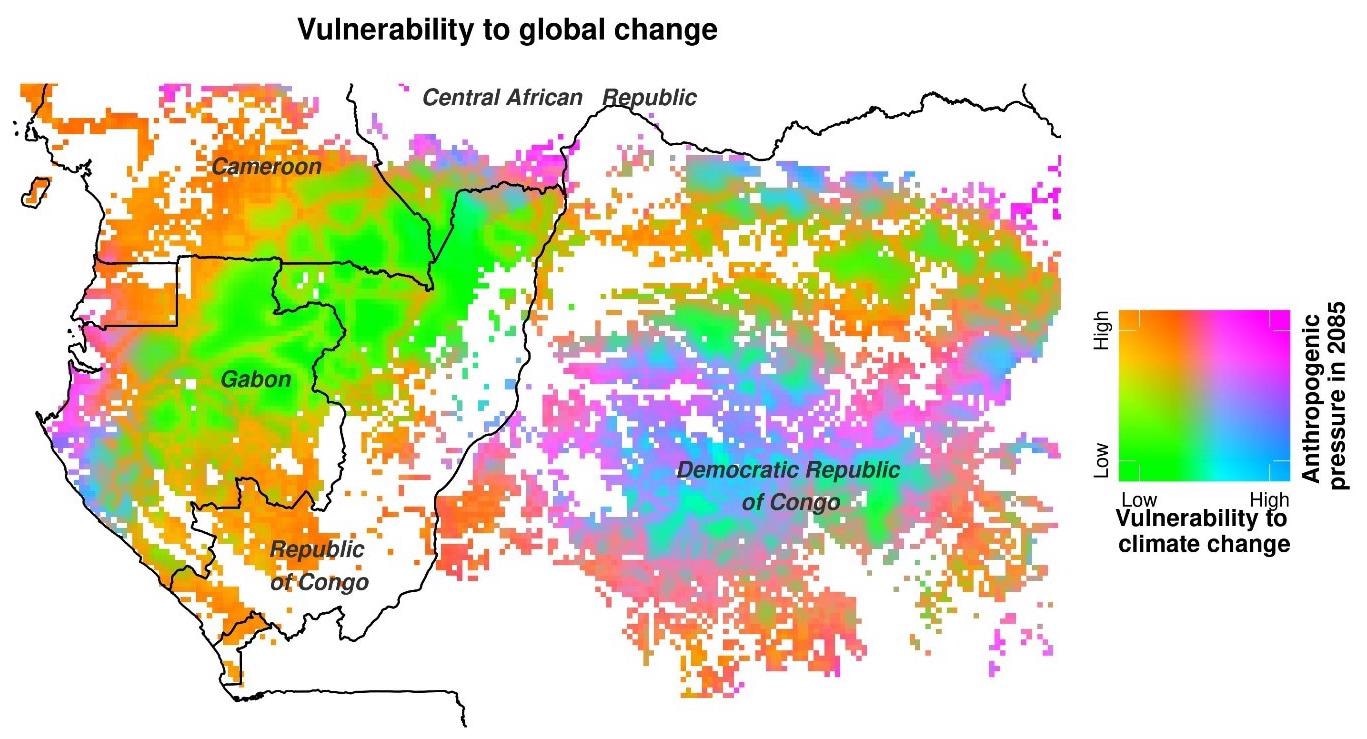Apr 22 2021
A global research work coordinated by scientists from the Institut de Recherche pour le Développement (IRD) and CIRAD has disclosed the composition of the tropical forests in Central Africa and their susceptibility to the rising pressure from human activity and climate change predicted in the forthcoming years.
 Gradient of the vulnerability of Central African forests to climate change and increased human pressure by 2085. The purple areas are the most vulnerable to climate change and human pressure; the green areas are the least vulnerable to both; the blue areas are very vulnerable to climate change and not very vulnerable to human pressure and vice versa for the orange areas. Image Credit: Institut de Recherche pour le Développement.
Gradient of the vulnerability of Central African forests to climate change and increased human pressure by 2085. The purple areas are the most vulnerable to climate change and human pressure; the green areas are the least vulnerable to both; the blue areas are very vulnerable to climate change and not very vulnerable to human pressure and vice versa for the orange areas. Image Credit: Institut de Recherche pour le Développement.
The team has now created the first continuous maps of the functional and floristic composition of the tropical forests using a unique dataset—an inventory of more than six million trees across five nations. This dataset enables the researchers to detect the most sensitive regions. The findings were published in the Nature journal on April 21st, 2021.
Central Africa has the second largest region of dense tropical rainforest in the world. This important reservoir of biodiversity extends across five major nations, such as the Central African Republic, the Democratic Republic of Congo, the Republic of Congo, Cameroon, and Gabon. The reservoir offers many different ecosystem services, like controlling exchange cycles between the atmosphere and the earth, and helps assure food supply for local inhabitants.
Threats from demographic pressure and climate change have been predicted in Africa toward the end of the 21st century and due to these factors, the sustainable management and protection of these forests pose a major challenge to policymakers. As such, a better understanding of these ecosystems is needed, specifically their composition and vulnerability to the ongoing changes.
Mapping Forest Composition and Vulnerability
During the analysis, the team worked with logging companies and forestry consultants to assemble a new inventory dataset of six million trees on more than 185,000 plots of land.
The researchers initially modeled and plotted the functional and floristic composition of Central African forests, taking functional characteristics into account, which included dominant foliage type (evergreen or deciduous), wood density, and the highest tree diameter.
They also estimated the susceptibility of these forests by considering the different climate conditions of the Intergovernmental Panel on Climate Change (IPCC) and the population projections of the United Nations toward the end of the century.
The forest area of Central Africa is far from being a homogeneous green carpet. It is home to a wide variety of forests with different characteristics, including their own particular carbon storage capacity.
Maxime Réjou-Méchain, Study First Author and Ecologist, IRD
“This diversity can be explained by the different types of climate (humidity, temperature, evapotranspiration rate, amount of rainfall) and soils, as well as by the history of the African flora and the degree of human activity that has disturbed the forests for thousands of years, such as shifting agriculture,” added Réjou-Méchain.
The team subsequently demonstrated that a few regions could be more vulnerable to climate change when compared to others.
For instance, “the forest margins in the north and south of the region, the Atlantic forests and most of those in the Democratic Republic of Congo, which is home to more than half of Central Africa’s forests, are among the most vulnerable,” explained Professor Bonaventure Sonké, the co-author of the study and a botanist from the University of Yaoundé 1.
Improving Strategies for Adaptation to Climate Change
Both the data and maps used in this analysis and available online on the Cirad data repository offer valuable information for investigators focused on the functioning of forests and their carbon storage potential and dynamics.
The diversity of forest types in Central Africa offers a wide range of potential responses to global changes. It is therefore an essential element to take into account in the framework of sustainable management policies and the fight against climate change.
Alfred Ngomanda, Study Co-Author, Ecologist, and Professor, CENAREST (Gabon)
“These results must now be used and applied to develop land use plans that preserve forest characteristics while maintaining connections between protected zones through sustainably managed timber production forests,” stated Sylvie Gourlet-Fleury, one of the main coordinators of the study and a forest ecologist at CIRAD.
In places where human pressure is too great, managers could re-establish these connections through biodiversity restoration programmes or the development of agroforestry.
Sylvie Gourlet-Fleury, Study Main Coordinator and Forest Ecologist, CIRAD
Journal Reference:
Réjou-Méchain, M., et al. (2021) Unveiling African rainforest composition and vulnerability to global change. Nature. doi.org/10.1038/s41586-021-03483-6.